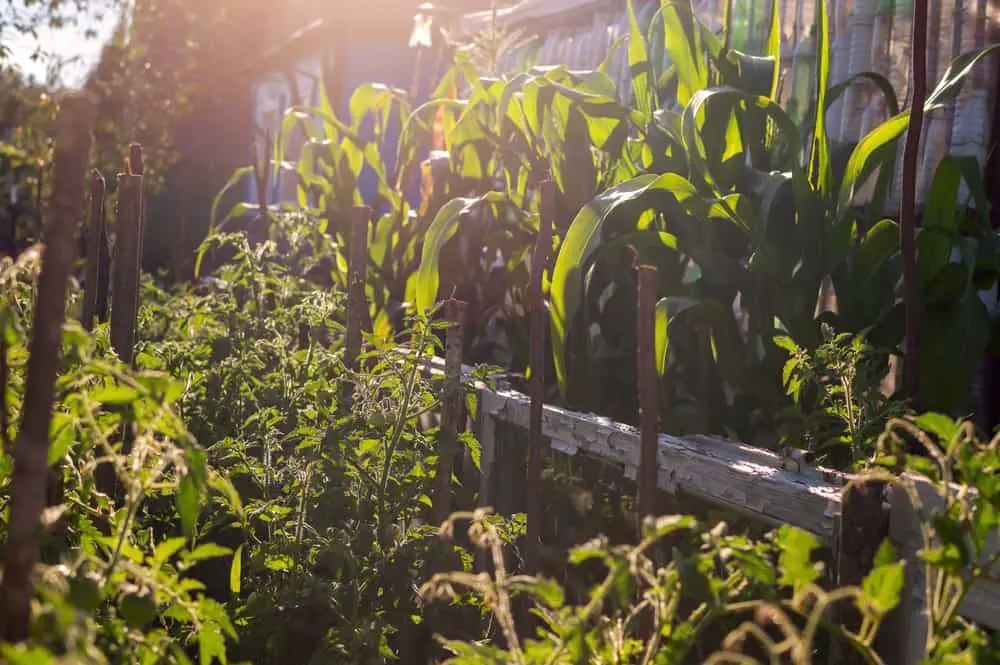Friends, frenemies, or worst enemies? Deciding what to plant near tomatoes is tough.
Make the wrong choice and your tomatoes may halt growing or be invaded by pests.
Whether you have a small plot or grow crops in containers, here are 22 plants you can grow near tomatoes and 18 to settle far away from them.
What Is Companion Planting?
Companion planting is the practice of growing two or more crops near each other, selecting the plants so that they can help one another with nutrients, pollination, pest control, and higher yields.
Companion species can be divided into two types:
- Pest Control And Pollination Aid: Some of these plants, including dill, cilantro, fennel, parsley, and basil, can attract and nourish beneficial insects that feed or ward off other garden pests (e.g. ladybird beetles, predatory mites, lacewings, spiders, and mantis). Others, such as rosemary or lavender, keep pests away with their strong odors. Flowers like marigolds and nasturtiums attract bees and butterflies, promoting pollination, while also enhancing pest control.
- Yield Maximization: Often referred to as intercropping, this technique involves pairing plants with different growing habits that can help one another. For instance, tomato plants can provide the shade lettuce needs. These plants need different nutrients, so they won’t compete against one another when planted in the same container.
Companion Planting Benefits
Smart plant pairing comes with multiple benefits. Here are a few reasons to consider it when planting your tomatoes:
- Decoy plants: Herbs and plants with strong odors can mask the scent of insect-desirable plants.
- Beneficial insects: Flowers can attract beneficial insects like bees and butterflies, promoting pollination and increasing yields.
- Soil improvement: Companion plants can improve soil quality for the plants around them. For instance, legumes can increase the nitrogen content of the soil around them, helping tomatoes and other plants in the tomato family grow strong.
- Shelter: Taller plants provide shade for shorter ones. This pairing works best for plants with different environmental tolerances, such as lettuce and tomatoes.
- Support: Some vegetables can provide natural support to climbing vines. For instance, pole beans can use corn as a trellis, eliminating the need for an actual trellis.
While companion plants can aid one another, not all edibles are friends. Choosing the right pairings is crucial if you don’t want to damage one or all companion plants.
Read on to find out which herbs and veggies are friends with tomatoes and which should be planted in a different container or on the other side of the yard.
22 Best Companion Plants For Tomatoes
1. Lettuce

- USDA Hardiness Zones: 3-10
- Environment Tolerance: Partial shade
Lettuce and tomatoes are a match made in heaven, especially when you have limited garden space.
Tomatoes grow tall and provide the shade that lettuce loves. They also deter lettuce pests including thrips and aphids.
Leaf lettuce, in its turn, covers the soil and keeps it cool. In this way, it inhibits the growth of weeds that could feed on the tomato nutrients.
Both plants also inhibit the spread of diseases causing rot, keeping each other and other garden neighbors healthy.
2. Asparagus
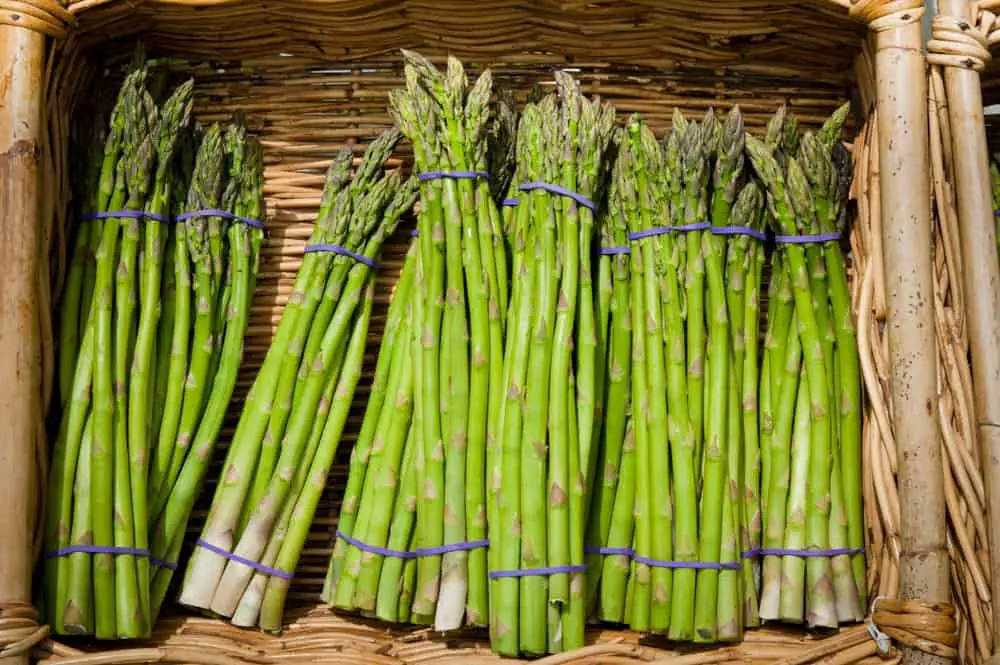
- USDA Hardiness Zones: 2-11
- Environment Tolerance: Full sun
Asparagus is a good companion for many plants, but it’s particularly notorious for pairing with tomatoes.
Once again, tomatoes act as pest deterrents, keeping asparagus beetles away. In turn, asparagus releases chemicals that deter nematodes.
Nematodes can easily affect tomato roots, so this pairing is a true winner.
3. Marigold
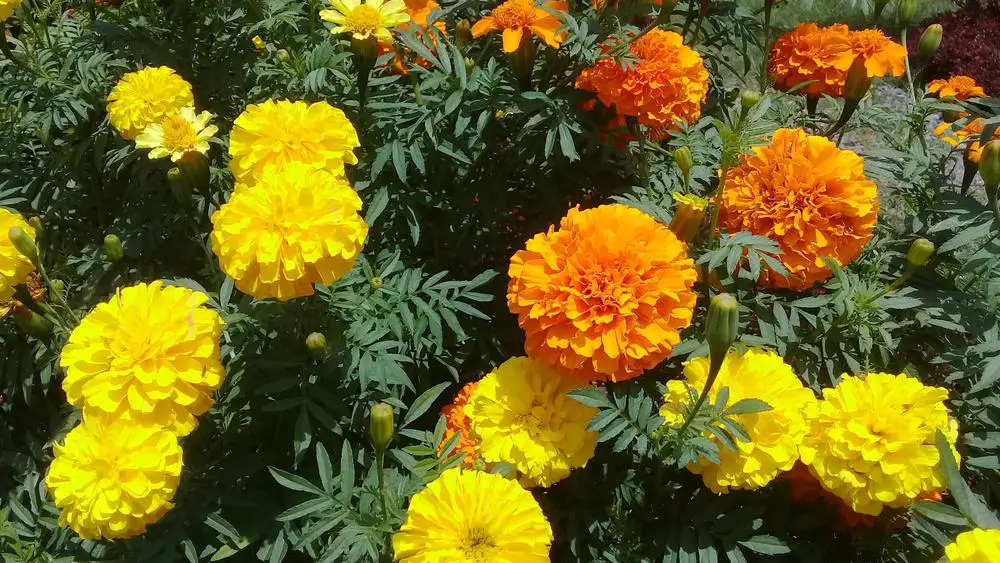
- USDA Hardiness Zones: 2-11
- Environment Tolerance: Full sun to partial shade
Marigolds are excellent vegetable companions that can keep tomatoes healthy while bringing a splash of color to the garden almost all year round.
They repel numerous pests, including nematodes and cabbage worms.
They also attract beneficial insects, such as ladybugs. Ladybugs are particularly fond of aphids, preventing them from invading your plants.
Marigolds also deter mosquitoes and whiteflies, another reason to keep them both in the garden and on the windowsill.
4. Basil

- USDA Hardiness Zones: 10-11
- Environment Tolerance: Full morning sun to light midday shade
The famous Italian dish Caprese salad is proof that tomatoes and basil work wonders in the kitchen. But they are friends in the garden, too.
Basil is an aromatic herb, and its strong scent acts as a natural repellent for a number of insects. You can trust basil to ward off spider mites, aphids, thrips, hornworms, and armyworms.
Allegedly, basil can also improve tomatoes’ flavor. While this is not scientifically proven, nothing takes away the fact that the two taste good together.
5. Sunflower

- USDA Hardiness Zones: 4-9
- Environment Tolerance: Full sun
True tomato defenders, sunflowers don’t get loads of benefits when sowed near tomatoes. However, they can help tomato plants grow stronger by repelling aphids.
During the blooming stage, tomatoes do attract some pollinators that can benefit sunflowers, though. Moreover, red fruits and yellow flowers truly look good together.
6. Garlic

- USDA Hardiness Zones: 1-5
- Environment Tolerance: Full sun
Tomatoes are also friends with most plants in the allium family, including garlic.
Like basil, garlic has a strong smell that repels spider mites, aphids, and other annoying pests. In fact, pests have such an abhorrence for garlic that you can even use it in homemade insecticides.
Crush a few cloves of garlic and mix them with water. Pour everything into a spray bottle and mist the tomatoes daily.
To keep pests causing root rot away, simply bury a clove of garlic next to each tomato plant.
7. Chives

- USDA Hardiness Zones: 3-10
- Environment Tolerance: Full sun to light shade
A fabulous companion herb, chives are cousins of garlic and repel insects in about the same way. They can also enhance the flavor of tomato fruits.
Since chives are a cool-season crop, they can also add color to your garden before other flowers have emerged.
Moreover, the lovely purple blooms are edible. You can use them, along with the stems, to prepare flavorful dishes.
8. Carrots

- USDA Hardiness Zones: 3-12
- Environment Tolerance: Full sun
Carrots and tomatoes are not exactly best friends. In fact, while carrots are tomato friends, tomato plants can inhibit the growth of the root vegetable.
That said, if you don’t mind harvesting small carrots, these two can help each other when planted together.
Carrots keep the soil around the tomato plant aerated, preventing root rot and enabling more oxygen and water to reach the plant.
Tomatoes produce solanine, a substance that acts as a natural insecticide against pests that attack carrots.
9. Buckwheat

- USDA Hardiness Zones: 3-10
- Environment Tolerance: Full sun
Tomatoes need a lot of soil nutrients to grow healthy, but they are especially fond of phosphorus. Buckwheat has a unique ability to mine this mineral into the soil, its proximity benefiting tomato plants.
Despite its shallow roots, buckwheat is also a phenomenal weed suppressor.
This pairing is perfect if you dream of outstanding tomato yields. Meanwhile, buckwheat can be used instead of rice or couscous in risotto-style dishes.
10. Peas

- USDA Hardiness Zones: 2-11
- Environment Tolerance: Full sun to partial shade
Like buckwheat, peas fix nutrients into the soil. In this case, it’s nitrogen, another element tomatoes love.
Peas also help increase air circulation around the tomato plant and reduce fungal disease.
Peas aside, tomatoes also pair well with all types of beans, and are a particularly good match with bush beans.
11. Radishes

- USDA Hardiness Zones: 2-11
- Environment Tolerance: Full sun to partial shade
Radishes and tomatoes are very good friends, especially if you live in a sub-tropical or tropical area.
These root vegetables prefer cool weather and benefit from the partial shade tomatoes provide when grown in hot climates.
Tomatoes also enrich the soil for radishes, providing them with essential nutrients.
In their turn, radishes repel flea and cucumber beetles that could feed on your tomatoes. They also repel other pests and prevent root diseases.
12. Celery

- USDA Hardiness Zones: 2-10
- Environment Tolerance: Full sun to partial shade
Tomatoes and celery make good bed companions, but neither of the two is particularly beneficial to the other.
Like radishes, celery prefers cooler zones and is a good tomato companion in hot areas where tomatoes are generally grown in winter.
13. Nasturtium

- USDA Hardiness Zones: 9-11 (perennial); all zones (annual)
- Environment Tolerances: Full sun to partial shade
Together with marigolds, nasturtiums are crop helpers that attract good and bad bugs alike.
Good bugs like bees and butterflies help in pollination and increase the yield. Bad bugs like aphids and other pests are attracted by the colorful plant and typically feed on it rather than attacking nearby vegetables.
The flowers are also edible. They have a peppery flavor that can add an extra touch to your dishes.
Nasturtiums grow as warm-season annuals in all USDA hardiness zones and are perennial in zones 9 to 11.
14. Onion

- USDA Hardiness Zones: 5-7
- Environment Tolerances: Full sun
Onion is a hardy plant that can grow in all climate zones. Nevertheless, it thrives in temperate climates (zones 5 to 7).
Wherever you grow it, though, onion pairs wonderfully with tomatoes. Like chives, it is part of the garlic family and repels pests with its strong odor.
These pungent vegetables can also keep pests away from your other edibles, including lettuce, strawberries, and peppers.
15. Cilantro

- USDA Hardiness Zones: 2-11
- Environment Tolerances: Full sun
Some love it, others hate it with a passion. Your tomatoes fall in the first group, as they are good friends with cilantro – or coriander, as it is also called.
This herb looks similar to parsley but it has a more pungent aroma (as well as a stronger taste) and can attract lots of good bugs to the garden.
Some good insects that like cilantro include minute pirate bugs and ladybugs, both of which feed on aphids.
Besides tomatoes, you can also interplant cilantro with peppers and other plants in the nightshade family.
16. Clover

- USDA Hardiness Zones: 3-10
- Environment Tolerances: Partial shade
If you only want to grow tomatoes in the garden, clover is a good choice to pair with your vegetables. This legume cover grows faster than grass and it can outcompete any weeds.
Like other legumes, including beans and peas, clover fixes nutrients into the soil, helping tomato plants grow larger and juicier fruits.
To enhance your cover crop, you can even plant clover interspersed with flowers like nasturtiums and marigolds.
17. Oats

- USDA Hardiness Zones: 6-7
- Environment Tolerances: Full sun
Like clover, oats are good companions for tomato plants if you need organic weed control.
Sow the oats after the tomato seedlings are established and watch these good grasses grow much faster than weeds.
Alternatively, you can plant tomatoes on a patch of land where oats have grown. Let the mowed stems on the soil and transplant right through them for natural mulch.
18. Borage
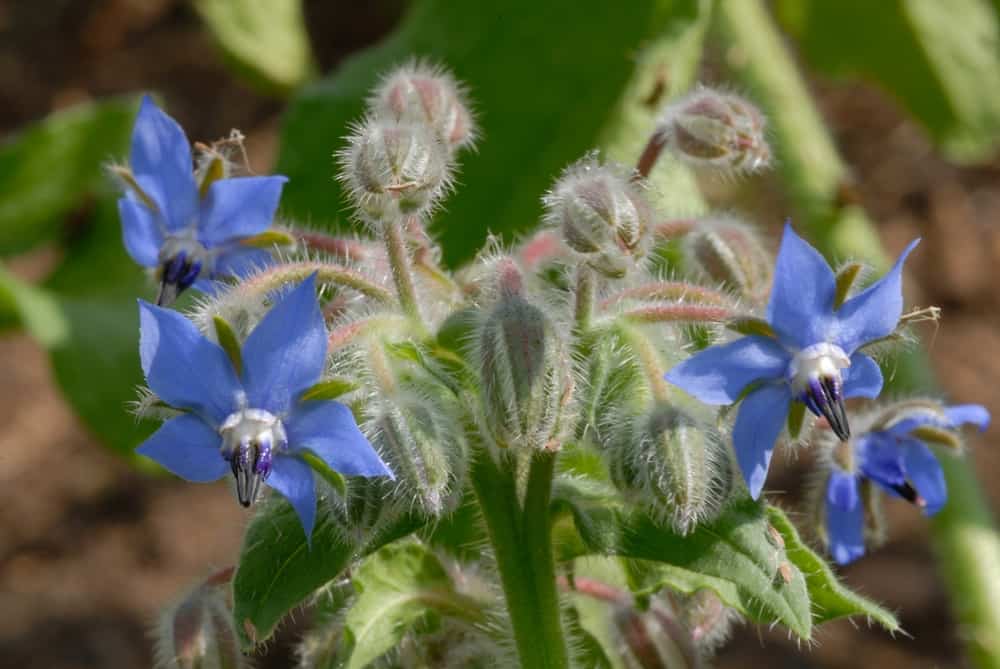
- USDA Hardiness Zones: 3-10
- Environment Tolerances: Full sun to partial shade
Also known as starflower, borage is an annual herb used for its health benefits. In the garden, it also helps tomatoes thrive.
The herb’s purple flowers attract numerous pollinators. It helps increase tomato yield and, allegedly, also makes the fruits taste better.
Borage also pairs well with other plants in the nightshade family and with strawberries.
19. Thyme

- USDA Hardiness Zones: 2-10
- Environment Tolerances: Full sun
A flavorful herb, thyme is another plant that attracts good bugs, keeps away the bad ones, and acts as natural mulch around the tomato plants.
This plant is perennial, so make sure to transplant it next to your tomatoes whenever you’re doing a crop rotation.
20. Lavender

- USDA Hardiness Zones: 5-9
- Environment Tolerances: Full sun; afternoon shade in very hot climates
Known for its soothing scent and sleep-inducing properties, lavender can add a splash of color to your garden and help your crops thrive.
It does that by attracting pollinators to your patch and keeping away some bad bugs.
Lavender also repels annoying insects such as mosquitoes, ticks, fleas, and flies. Tomatoes aside, lavender pairs well with peas, beans, other nightshades, and basil.
21. Zucchini

- USDA Hardiness Zones: 3-9
- Environment Tolerances: Full sun
Zucchini and tomatoes thrive in the same conditions, but their growth differences make them good companions nonetheless.
Despite the competition for nutrients, zucchini’s large leaves keep the soil cool, deterring pests.
At the same time, tomatoes attract pollinators that increase the yield of both crops. The go-to third partner in this pairing is borage, which can be beneficial to both plants.
22. Spinach

- USDA Hardiness Zones: 5-10
- Environment Tolerances: Full sun to partial shade
Tomatoes pair with spinach in the same way they pair with lettuce.
Spinach keeps the soil cool and deters pests. Tomatoes attract pollinators and provide partial shade when spinach is grown in hot climate zones.
18 Bad Companion Plants For Tomatoes
1. Peppers

- USDA Hardiness Zones: 9-11
- Environment Tolerances: Full sun
- Successful Pairings: Basil, beets, Brussels sprouts
Peppers and tomatoes are both in the nightshade family and have similar soil and nutrient requirements. They can be grown together successfully, especially in containers.
However, both plants also attract the same pests and diseases, including verticillium wilt and bacterial spot. This is why you should avoid the pairing.
2. Cabbage

- USDA Hardiness Zones: 1-10
- Environment Tolerances: Full sun
- Successful Pairings: Chives, mint, sage, chamomile, summer savory
Tomatoes and cabbage are sworn enemies that should never be grown together.
The former likes full sun and grows tall. Cabbages like the full sun too, but tomatoes would keep them in partial shade.
Both plants are voracious and need lots of nutrients, but cabbages consume them faster and inhibit tomato growth.
In fact, cabbages don’t pair well with many vegetables, and it’s best to sow them next to herbs.
3. Corn

- USDA Hardiness Zones: 3-11
- Environment Tolerances: Full sun
- Successful Pairings: Potatoes, pumpkins, radishes
Growing corn in the garden is more than rewarding, especially when you want to throw an organic cob on the grill. But don’t grow it near tomatoes, though.
Corn attracts pests, such as tomato fruit worms. It also grows tall, towering over tomatoes and keeping them in partial shade.
As such, tomato fruits will remain small and take longer to ripe – that is, if the worms don’t eat them before it’s harvest time.
4. Fennel
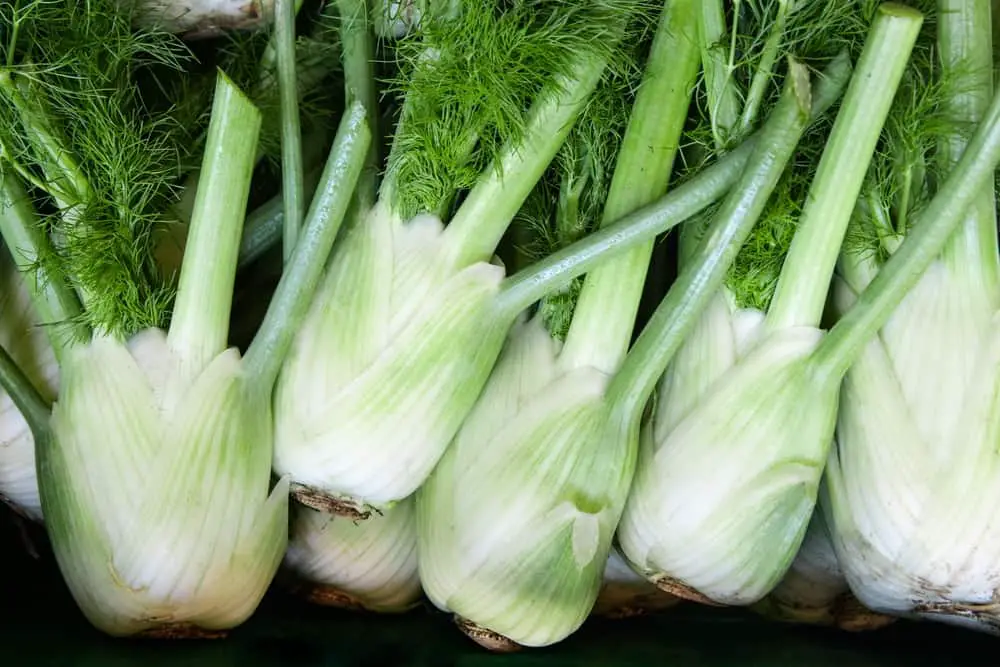
- USDA Hardiness Zones: 4-9
- Environment Tolerances: Full sun
- Successful Pairings: Dill
A true loner, fennel doesn’t get along with any vegetable, and it isn’t a friend of many herbs either. In fact, it only grows well with dill.
As for all other pairings, fennel inhibits the growth of all vegetables. Sow it in a separate patch to prevent trouble.
5. Eggplant

- USDA Hardiness Zones: 4-10
- Environment Tolerances: Full sun
- Successful Pairings: Leafy greens, peas, beans
Another plant in the nightshade family, eggplant can grow next to tomatoes, but it’s best to keep them separate.
Beyond competition from nutrients – which can be overcome if you keep the soil fertilized – these plants attract the same pests and diseases. Instead, grow your eggplants next to leafy greens like lettuce and spinach.
6. Potatoes

- USDA Hardiness Zones: 3-10
- Environment Tolerances: Full sun
- Successful Pairings: Chamomile, coriander, corn, cabbage
Potatoes are nightshades too, so they can attract the same diseases and pests as tomatoes, eggplant, and peppers. However, you can make them work with tomatoes if you really want to.
To stay on the safe side and increase the yield of each plant, you can even get a TomTato hybrid, which grows tomatoes on top and potatoes underground. This one is perfect for a balcony or micro garden.
7. Dill

- USDA Hardiness Zones: 3-11
- Environment Tolerance: Full sun
- Successful Pairings: Asparagus, cucumber, onion, lettuce
Dill and tomatoes have a sort of frenemy relationship. Essentially, dill can attract predators of tomato pests and improve the health of your tomato plants.
However, tomatoes inhibit dill growth during the seedling stage. If transplanted near tomatoes as a mature plant, dill can inhibit tomato growth.
So, unless you’re struggling to get rid of tomato hornworm, keeping these two apart is for the best.
8. Kohlrabi
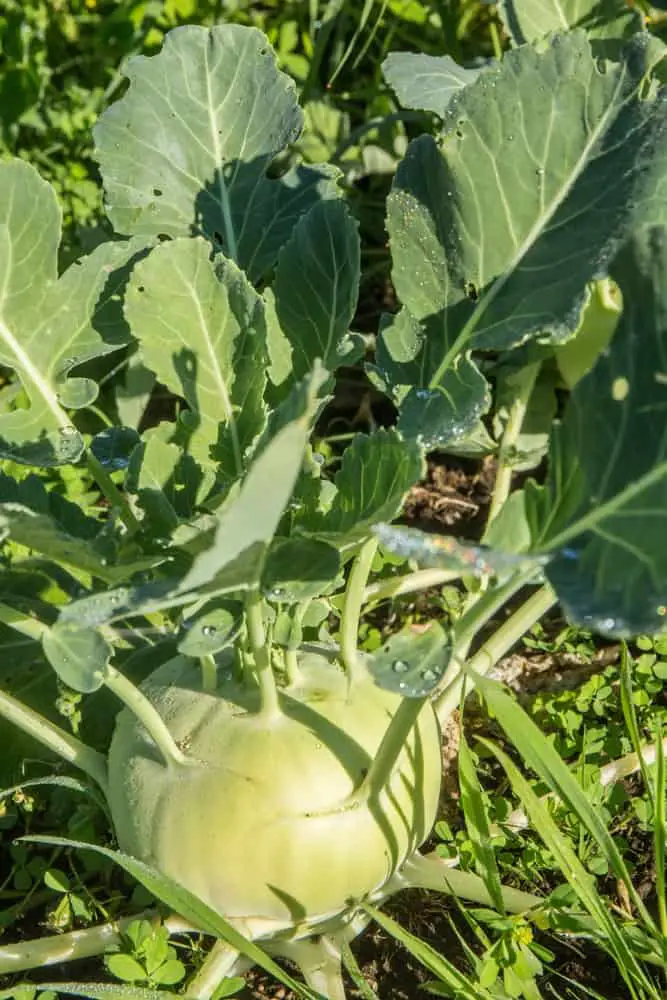
- USDA Hardiness Zones: 3-9
- Environment Tolerance: Full sun
- Successful Pairings: Beets, cucumbers, onions
Also called German turnip, kohlrabi is a cruciferous vegetable like broccoli and cabbage. It doesn’t trouble tomato plants too much, but it likes the same stuff.
When planted next to each other, these veggies will compete for nutrients and stunt each other’s growth.
9. Rutabaga
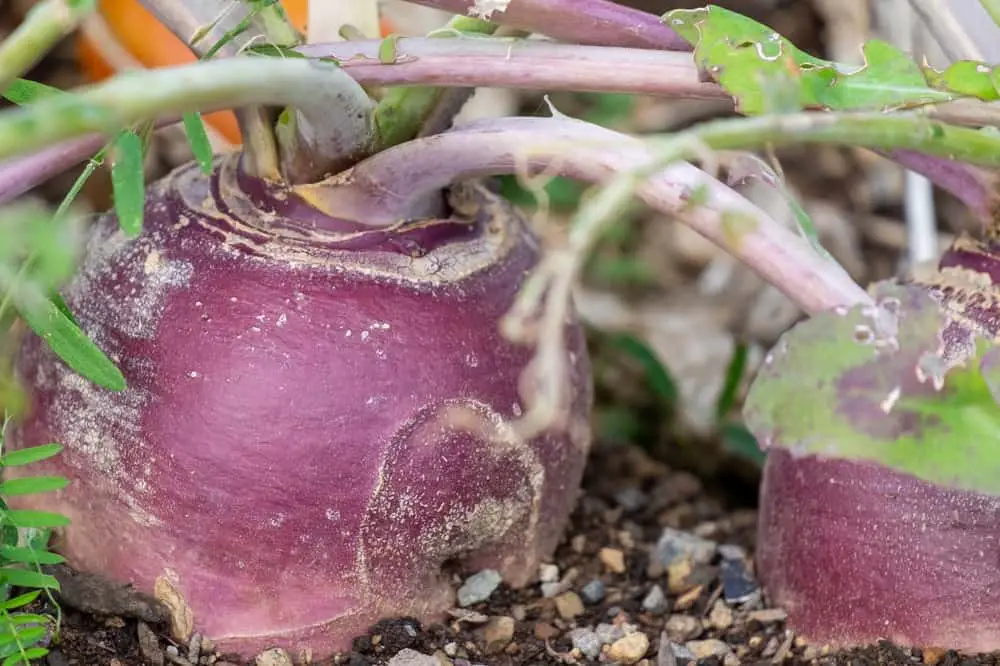
- USDA Hardiness Zones: 3-9
- Environment Tolerance: Full sun to light shade
- Successful Pairings: Chives, carrots, beets
Similar to kohlrabi, rutabaga dislikes tomatoes.
These plants compete for nutrients and can inhibit each other’s growth.
10. Cauliflower

- USDA Hardiness Zones: 2-11
- Environment Tolerance: Full sun
- Successful Pairings: Spinach, cucumber, chard
Cauliflowers are tasty vegetables often used in hot salads. They are healthy too, and quite easy to grow in the garden.
However, they shouldn’t stay next to your tomatoes.
Both vegetables need tremendous amounts of nutrition and they happen to like the same stuff. Hence, they’ll inhibit each other’s growth. Sow cauliflowers next to cucumbers, spinach, and chard.
11. Broccoli
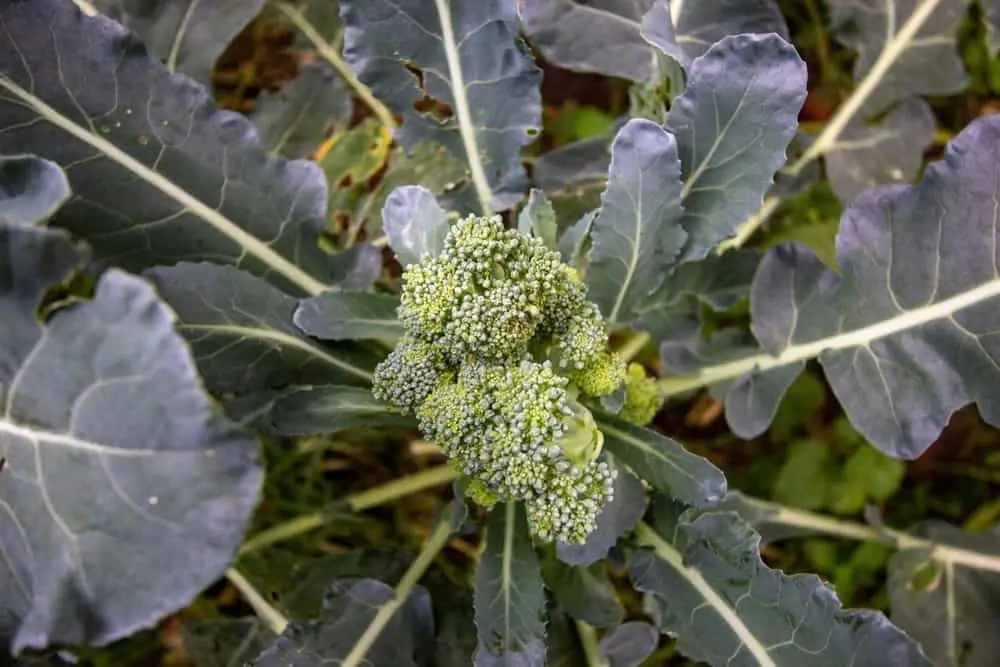
- USDA Hardiness Zones: 2-11
- Environment Tolerance: Full sun
- Successful Pairings: Shallots, celery, lettuce, rhubarb
If broccoli were to pick one member of the nightshade family they dislike the least, it would be the tomatoes. These two can even be grown together successfully with some care (aka, lots of fertilizer).
The truth is, they are both heavy feeders and compete for nutrients, so you’ll have smaller veggies and lower yields.
12. Kale

- USDA Hardiness Zones: 7-9
- Environment Tolerance: Full sun to partial shade
- Successful Pairings: Lettuce, onions, peas
Tomatoes are friends with most leafy greens, but not with kales. These vegetables compete for nitrogen, and tend to become underdeveloped when grown next to each other.
Smaller and weaker plants are more susceptible to parasites and diseases and have lower yields.
13. Beets

- USDA Hardiness Zones: 2-11
- Environment Tolerance: Full sun
- Successful Pairings: Aromatic herbs, bush beans, radishes
Beets are well-adapted to most climates and thrive in full sun. Their purplish-red roots are also flavorful, so they’re a popular crop – just like tomatoes.
But even if you have a small space, you should avoid growing these two together. Once again, the problem is the competition for nutrients.
14. Rosemary

- USDA Hardiness Zones: 7-10
- Environment Tolerance: Full sun
- Successful Pairings: Lavender, oregano, marjoram
Rosemary is a beloved Mediterranean herb that pairs wonderfully with tomatoes in the kitchen. The two don’t love each other too much in the garden, though.
In fact, rosemary often deprives tomatoes of nutrients, causing the vegetable to grow weak. Thus, your tomatoes will produce less and become more susceptible to parasites and diseases.
15. Melon

- USDA Hardiness Zones: 4-10
- Environment Tolerance: Full sun
- Successful Pairings: Pole beans, onions, leeks
Like cabbages, melons are plants that should be friends with tomatoes.
But they aren’t, because taller tomato plants keep them in partial shade, whereas melons are faster in depleting the soil of nutrients.
Keep them separated.
16. Strawberries

- USDA Hardiness Zones: 5-10
- Environment Tolerance: Full sun
- Successful Pairings: Cilantro, catnip, sage
Tomato enemies typically deplete the soil of the nutrients tomatoes need. This isn’t the case with strawberries – in this case, tomatoes can damage the sweet berries.
All plants in the nightshade family can spread a fungal disease that is deadly for the strawberries.
17. Quinoa

- USDA Hardiness Zones: 4-10
- Environment Tolerance: Full sun
- Successful Pairings: Rue, garlic, mint
Quinoa may not be jam-packed in nutrition, but it tastes wonderful when paired with tomatoes in the kitchen. It also produces lovely flowers that can add a splash of color to your garden.
That said, you shouldn’t plant quinoa and tomatoes in the same patch. These plants share common pests and diseases.
18. Cucumbers
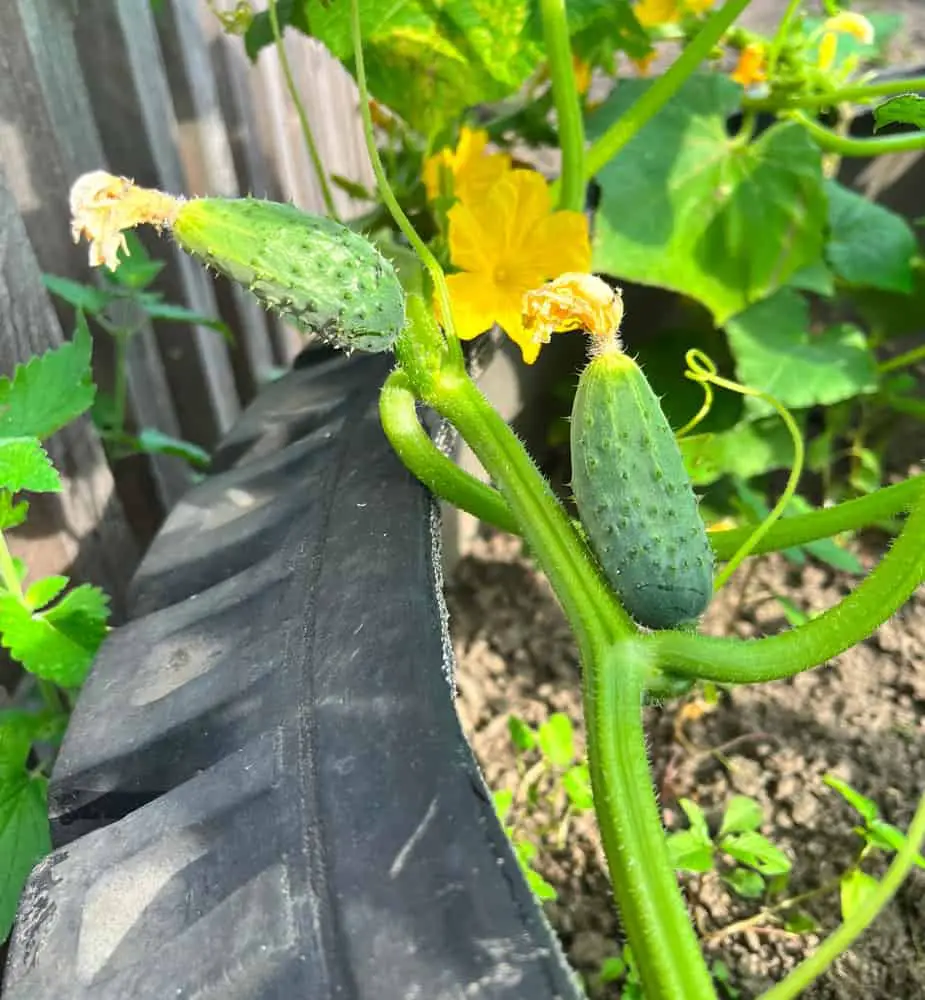
- USDA Hardiness Zones: 4-12
- Environment Tolerance: Full sun
- Successful Pairings: Legumes, herbs, root vegetables
In another case of frenemies, cucumbers and tomatoes can grow together if they have to, as long as the soil is packed with nutrients.
However, they have similar nutritional needs and can compete for the good stuff. This could mean lower yields on both plants.
To Wrap Up
Tomatoes are good friends with plants in the allium family, leafy greens, asparagus, and zucchini. They also thrive when paired with legumes or herbs such as basil or thyme.
They aren’t great friends with cabbage, cucumbers, or quinoa, and don’t tolerate well pairings with other nightshade vegetables either.
Hopefully, this guide can help you find the best companions for your tomato plants.
